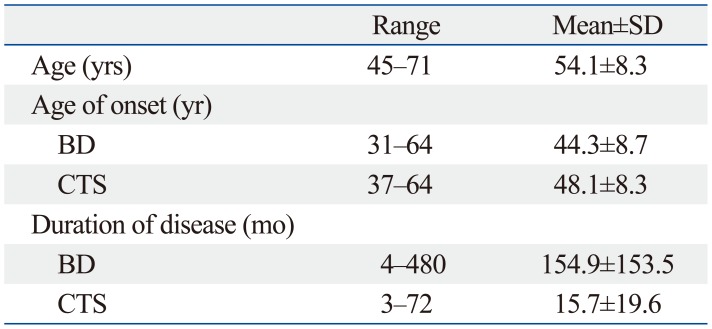1. James DG. Behcet's syndrome. N Engl J Med. 1979; 301:431–432. PMID:
460347.
2. Siva A, Altintas A, Saip S. Behçet's syndrome and the nervous system. Curr Opin Neurol. 2004; 17:347–357. PMID:
15167071.

3. Atasoy HT, Tunc TO, Unal AE, Emre U, Koca R, Esturk E, et al. Peripheral nervous system involvement in patients with Behçet disease. Neurologist. 2007; 13:225–230. PMID:
17622917.

4. Akbulut L, Gur G, Bodur H, Alli N, Borman P. Peripheral neuropathy in Behçet disease: an electroneurophysiological study. Clin Rheumatol. 2007; 26:1240–1244. PMID:
17149536.

5. Onder M, Gürer MA. The multiple faces of Behçet's disease and its aetiological factors. J Eur Acad Dermatol Venereol. 2001; 15:126–136. PMID:
11495519.
6. Siva A, Kantarci OH, Saip S, Altintas A, Hamuryudan V, Islak C, et al. Behçet's disease: diagnostic and prognostic aspects of neurological involvement. J Neurol. 2001; 248:95–103. PMID:
11284141.

7. Kidd D, Steuer A, Denman AM, Rudge P. Neurological complications in Behçet's syndrome. Brain. 1999; 122(Pt 11):2183–2194. PMID:
10545402.

8. Akman-Demir G, Baykan-Kurt B, Serdaroglu P, Gürvit H, Yurdakul S, Yazici H, et al. Seven-year follow-up of neurologic involvement in Behçet syndrome. Arch Neurol. 1996; 53:691–694. PMID:
8929179.
9. Namer IJ, Karabudak R, Zileli T, Ruacan S, Küçükali T, Kansu E. Peripheral nervous system involvement in Behçet's disease. Case report and review of the literature. Eur Neurol. 1987; 26:235–240. PMID:
3595663.
10. Lannuzel A, Lamaury I, Charpentier D, Caparros-Lefebvre D. Neurological manifestations of Behçet's disease in a Caribbean population: clinical and imaging findings. J Neurol. 2002; 249:410–418. PMID:
11967645.

11. Akbulut L, Gur G, Bodur H, Alli N, Borman P. Peripheral neuropathy in Behçet disease: an electroneurophysiological study. Clin Rheumatol. 2007; 26:1240–1244. PMID:
17149536.

12. Birol A, Ulkatan S, Koçak M, Erkek E. Peripheral neuropathy in Behçet's disease. J Dermatol. 2004; 31:455–459. PMID:
15235183.

13. Kim HA, Choi KW, Song YW. Arthropathy in Behçet's disease. Scand J Rheumatol. 1997; 26:125–129. PMID:
9137328.
14. Walker-Bone K, Palmer KT, Reading I, Coggon D, Cooper C. Prevalence and impact of musculoskeletal disorders of the upper limb in the general population. Arthritis Rheum. 2004; 51:642–651. PMID:
15334439.

15. Uchiyama S, Itsubo T, Nakamura K, Kato H, Yasutomi T, Momose T. Current concepts of carpal tunnel syndrome: pathophysiology, treatment, and evaluation. J Orthop Sci. 2010; 15:1–13. PMID:
20151245.

16. International Study Group for Behçet's Disease. Criteria for diagnosis of Behçet's disease. Lancet. 1990; 335:1078–1080. PMID:
1970380.
17. Kurokawa MS, Yoshikawa H, Suzuki N. Behçet's disease. Semin Respir Crit Care Med. 2004; 25:557–568. PMID:
16088499.
19. Cho SB, Cho S, Bang D. New insights in the clinical understanding of Behçet's disease. Yonsei Med J. 2012; 53:35–42. PMID:
22187230.

20. Sakane T, Takeno M, Suzuki N, Inaba G. Behçet's disease. N Engl J Med. 1999; 341:1284–1291. PMID:
10528040.

21. Kalayciyan A, Zouboulis C. An update on Behsçet's disease. J Eur Acad Dermatol Venereol. 2007; 21:1–10. PMID:
17207160.
22. Bongers FJ, Schellevis FG, van den Bosch WJ, van der Zee J. Carpal tunnel syndrome in general practice (1987 and 2001): incidence and the role of occupational and non-occupational factors. Br J Gen Pract. 2007; 57:36–39. PMID:
17244422.
23. Street ER, Eastwood GL, Royle SG. Staged release of bilateral carpal tunnel syndrome: cancellation rates of the second side procedure. J Hand Surg Eur Vol. 2013; 38:552–553. PMID:
23172822.

24. Budak F, Efendi H, Apaydin R, Bilen N, Komsuoglu S. The F response parameters in Behçet's disease. Electromyogr Clin Neurophysiol. 2000; 40:45–48. PMID:
10782357.
25. Pirzada NA, Medell M, Ali II. Colchicine induced neuromyopathy in a patient with normal renal function. J Clin Rheumatol. 2001; 7:374–376. PMID:
17039178.

26. Altiparmak MR, Pamuk ON, Pamuk GE, Hamuryudan V, Ataman R, Serdengecti K. Colchicine neuromyopathy: a report of six cases. Clin Exp Rheumatol. 2002; 20(4 Suppl 26):S13–S16. PMID:
12371628.
27. Dalvi SR, Yildirim R, Yazici Y. Behcet's Syndrome. Drugs. 2012; 72:2223–2241. PMID:
23153327.

28. Verdugo RJ, Salinas RA, Castillo JL, Cea JG. Surgical versus non-surgical treatment for carpal tunnel syndrome. Cochrane Database Syst Rev. 2008; CD001552. PMID:
18843618.
29. Melikoglu M, Uysal S, Krueger JG, Kaplan G, Gogus F, Yazici H, et al. Characterization of the divergent wound-healing responses occurring in the pathergy reaction and normal healthy volunteers. J Immunol. 2006; 177:6415–6421. PMID:
17056573.

30. Yazici H, Yurdakul S, Hamuryudan V. Behçet disease. Curr Opin Rheumatol. 2001; 13:18–22. PMID:
11148711.






 PDF
PDF ePub
ePub Citation
Citation Print
Print



 XML Download
XML Download